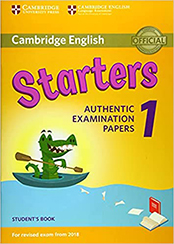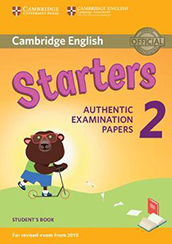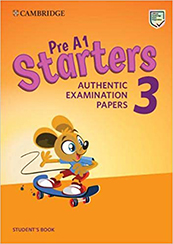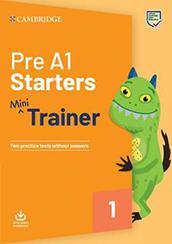The tests Cambridge English: Young Learners, also known as Young Learners English (YLE), measure how well 7 to 12-year-olds perform in the skills of listening, speaking, reading, and writing. Tests are designed to make learning fun and encourage children to work towards certificates and earning “shields” that record their progress.
Pre A1 Starters is the first of three Cambridge English Qualifications designed for young learners. Pre A1 Starters is offered for the first time in digital form, alongside its traditional paper-based version, with multiple exam administrations in test centers throughout Greece. Pre A1 Starters Digital gives children their first taste of English in a way that amuses, motivates and rewards them throughout. Children create themselves as avatars and work their way along a map across a turtle island, completing tasks and earning rewards.
Pre A1 Starters and Pre A1 Starters Digital introduce children to everyday written and spoken English, through tasks designed to reflect the world they're growing up in. They have been developed based on decades of world-leading expertise in language testing for young learners. Aligned to the Common European Framework of Reference for Languages (CEFR), they provide clear milestones, goals and next steps.
Paper 1: Listening
Duration: about 20 minutes
Number of parts: 4 parts
Candidates write their answers in the question paper booklet using pen or pencil in parts 1 to 3 and coloured pencils or markers in part 4.
Number of questions: 20 questions in total
Marks: a maximum of five shields
Part 1 (5 questions)
A big picture which shows people doing different things. Above and below the picture are some names. Candidates have to listen carefully to a conversation between an adult and a child and draw a line from each name to the correct person on the big picture
Part 2 (5 questions)
A short conversation between a child and an adult and some questions. Candidates will listen to the recording and write the correct answer (a name or a number) after each question.
Part 3 (5 questions)
Five short conversations between different pairs of people. For each conversation there is a question and three pictures. Candidates need to listen carefully to each conversation and choose the right answer (A, B or C).
Part 4 (5 questions)
A big picture which has seven examples of the same object (for example seven balls or seven books). Candidates need to listen carefully to a conversation between an adult and a child and colour (black, blue, brown, green, grey, orange, pink, purple, red, yellow) each object using the colour they say in the conversation.
Paper 2: READING & WRITING
Duration: 20 minutes
Number of parts: 5 parts
Candidates write their answers in the question paper booklet using pen or pencil.
Number of questions: 25 questions in total
Marks: a maximum of five shields
Part 1 (5 questions)
Five pictures of objects. Under each picture there is a sentence which begins ‘This is a…’ or ‘These are…’. If the sentence is correct, candidates should put a tick next to the picture. If the sentence is not true, candidates should put a cross.
Part 2 (5 questions)
A big picture and some sentences about it. If the sentence is correct, candidates should write 'yes'; if the sentence is not true, candidates should write 'no'.
Part 3 (5 questions)
Five pictures of objects. Candidates have to find the right word in English for the object. After each picture there are some dashes (- - -) to show how many letters are in the word, and some jumbled letters. Candidates have to put the jumbled letters in the right order to make the word.
Part 4 (5 questions)
A semi-factual text which has some missing words (gaps). Below the text there is a box with some pictures and words. Candidates have to choose the right words from the box and copy it into each gap.
Part 5 (5 questions)
Three pictures which tell a story. Each picture has one or two questions. Candidates have to look at the pictures and write the answer to each question. Candidates only have to write one word for each answer.
Paper 3: SPEAKING
Duration: 3-5 minutes
Number of parts: 4 parts
Marks: a maximum of five shields
Part 1
After asking the candidate ‘What’s your name?’, the examiner familiarises the candidate with the picture first and then asks the candidate to point out certain items on the scene picture, e.g. ‘Where’s the door?’ The examiner then asks the candidate to put two object cards in various locations on the scene picture, e.g. ‘Put the robot on the red chair.’.
Part 2
The examiner asks questions about two of the people or things in the scene picture, e.g. ‘What’s this?’ (Answer: banana) or ‘What colour is it?’ (Answer: yellow). The examiner also asks the candidate to describe an object from the scene, e.g. ‘Tell me about this box.’
Part 3
The examiner asks questions about four object cards, e.g. ‘What’s this?’ (Answer: (juice/orange juice)) and ‘What do you drink for lunch?
Part 4
The examiner asks questions about the candidate, e.g. ‘Which sport do you like?’ .
Section 1: Listening
Time: maximum 40 minutes
Tasks: 5 (25 questions)
For the Listening test, headphones with volume control help test takers listen comfortably and concentrate to perform the best of their abilities. Test takers use their mouse to select and submit their answers. The Pre A1 Starters Digital Listening test is a digital component consisting of five tasks. Each task starts with an example. In most tasks, children will hear the audio twice. In task 4, they can listen as many times as they need.
Marks: a maximum of 5 shields
Task 1: Minimal differences (2 questions)
Candidates listen to a short sentence or phrase and select the correct picture from a choice of three. They practise hearing the different letter sounds in words.
Task 2: Story scene (5 questions)
Candidates listen to and understand details in a story, as well as select correct pictures from a choice of three. They practise listening to short, simple stories at this level.
Task 3: Note-taking (5 questions)
Candidates listen for spellings and numbers, and drag and drop letters and numbers to complete a set of notes. They practise spelling and writing words, counting and pronouncing numbers.
Task 4: Interactive dialogue (3 questions)
Candidates listen to questions/prompts and choose the appropriate response from a choice of three. They practise answering open and closed questions with short replies.
Task 5: Picture editing (5 questions)
Candidates listen to the descriptions and follow the instructions by dragging and dropping objects into the correct place in the picture (questions 1-3) and by colouring objects with digital crayons (questions 4 and 5). They practise using prepositions, colours, acting on instructions, asking and answering questions about where something is.
Section 2: Reading and Writing
Time: maximum 25 minutes
Tasks: 5
The Pre A1 Starters Digital Reading and Writing test is a digital component consisting of five tasks. Each task starts with an example. Test takers use their keyboard and mouse to select, compose and submit their answers.
Marks: a maximum of 5 shields
Task 1: Information posters (5 questions)
Candidates read a short phrase on a poster and choose the correct picture from a choice of three to add to it. They practise matching pictures to words from the Pre A1 Digital wordlist.
Task 2: Online messages (5 questions)
Candidates read a text/online message exchange and choose the correct picture, emoji, or sticker from a choice of three. They practise reading and responding to short messages.
Task 3: Spelling (5 questions)
Candidates complete words by choosing the correct letter combinations (questions 1 and 2) and unscrambling the letters (questions 3-5). They practise spelling short, simple words.
Task 4: Factual topic (5 questions)
Candidates read some sentences on a factual topic and drag and drop a word to fill the gap in each sentence. They practise reading short factual texts, guessing what missing words might be.
Task 5: Comic book story (5 questions)
Candidates type one-word answers to questions about a picture story. They practise copying words from a story (questions 1-3) and writing words identified in a picture (questions 4-5).
Section 3: Speaking
Time: 3-5 minutes
Tasks: 4
The Pre A1 Starters Digital Speaking test is a face-to-face component consisting of four tasks. Children take the test alone with the examiner, but someone they know who speaks their language (like their teacher) will introduce them to the examiner and explain what to do in their own language.
Marks: a maximum of 5 shields
Task 1: Scene picture and object cards
Candidates point to correct parts of a picture, and place object cards on the scene picture as directed. They practise identifying people, animals and things in different pictures.
Task 2: Scene picture
Candidates give short answers to questions, including a "Tell me about..." question. They practise answering simple questions about pictures.
Task 3: Object cards
Candidates give short answers to questions. They practise giving one-word answers to simple questions about pictures.
Task 4: Personal questions
Candidates give short answers to questions. They practise answering questions on basic information about themselves.
Register online for your exams through ORFEAS, our online registration system. Find an examination center close to home from a choice of 100 locations throughout Greece and abroad, and complete your application online with your debit, pre-paid or credit card.
You will receive all the details for your upcoming exam via email in a single document that you can save, print and take with you on the day of your test. You will also be sent updates on the status of your application and useful support materials. Expect invitations to webinars for tips and strategies that will help you prepare effectively for the exam.
The ORFEAS registration system does away with print application forms and visits to the bank. Start and complete your registration online in a few simple steps. Use your home computer, tablet or smartphone to apply for your exam.
The Pre A1 Starters certificate celebrates children’s achievement, builds their confidence and rewards their ability in the use of the English language. There is no pass or fail score in the results of Pre A1 Starters. All children receive a certificate which shows how well they performed in each part of the test by the number of shields they have received, out of a maximum of five.
A result of one shield means a child can improve a lot in that skill. Five shields mean a child did very well in that skill and answered most questions correctly. If a child has earned four or five shields in each skill, they are ready to start preparing for the next Cambridge English qualification - A1 Movers Digital.
The back of the certificate shows how results align to the CEFR. The following factsheet can be used as a guide to help teachers and candidates understand how Cambridge English scale works.
Statement of results
All children will receive a statement of results as well as their certificate.
The statement of results includes:
- the number of shields they have received for each part of the test
- information on their strengths
- areas for improvement and ideas for how to improve
View a sample statement of results for the Pre A1 Starters test
Results
Please find information regarding the results of the Cambridge University Press & Assessment exams here.
Results and Certificates Services
Discover our available results and certificates services. Learn how you can request, among other things, the rescoring of your test, the notarization of a copy of a certificate, and the issuance of a certification of loss of a certificate.
How can I apply?
Use this link to enter the ORFEAS online registration system. From there, follow the steps as suggested. Choose your exam, date and venue and then provide your personal details. In the last step you will be asked to pay with your card of choice. All the information you will need for the day of the exam will arrive in your inbox via email and SMS.
What if I have a question about the procedure?
If you have any questions about the procedure, even as you complete the steps in the process, contact us on 2103680000 for assistance. We have staff available from 9 am - 7 pm on weekdays to help you complete the registration process and answer your questions.
Can I see the status of my registration after I have applied?
Once you complete your registration you will be sent updates on the status of your application. For example, any changes to the date of the examination, if these occur, will be communicated to you via email, SMS or telephone by our support team.
Schedule
| Exam Date: | Exam Administration: | Test Centers: | Registration Period: |
|---|---|---|---|
|
|
|
Registration Period:
|
Support
Find useful information for your exams or existing certifications, tips and advice, free preparation material and more.





